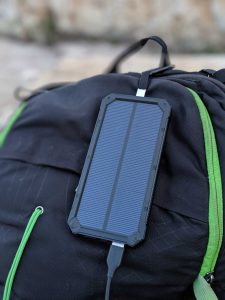With advancements in the efficiency of solar equipment and technology, solar panels are no longer just capable of powering your homes. In fact, from RVs to boats to sheds, solar on a smaller scale can keep many things running outside of your home. One way that this smaller-scale solar technology is being used today is in solar-powered camping gear.
Why go camping with solar panels?
You may be thinking to yourself: I go camping to get away from technology, why would I need solar-powered camping gear? Solar camping equipment goes far beyond just allowing you to recharge your phone every day in the wilderness. In fact, solar-powered camping gear is a low-cost way to add a few luxuries to your camping experience, and some are even great for lightweight camping situations. Solar-powered camping gear can also be useful outside of pure backcountry or camping trips, and has applications in international travel, road-tripping, and living in remote locations with limited access to the grid.
Different types of solar panels for camping
Solar-powered camping equipment allows you to harness the power of the sun and take it with you, whether you’re traveling without access to electricity, spending a weekend car camping, or on a long backcountry adventure. While the possibilities and offerings for solar camping equipment are endless, the main solar camping products you’ll see generally fall into three categories: lanterns, charging stations and camp showers.
Solar camping lanterns

My personal favorite piece of solar camping gear is a solar lantern. While some solar camping lanterns are larger, wired together like Christmas lights, and generally designed for car camping or outdoor lighting even in your backyard, my favorite solar lantern is the Luci: an inflatable solar light. The charge on the Luci is great, with a single sunny afternoon able to power its light for multiple nights. The light is adjustable from a brightness and color perspective (depending upon which one you have). The best part is how compact and lightweight it is when deflated, making the Luci ideal to throw in your bag before leaving for a trip.
Solar charging stations

Portable solar charging stations are incredibly useful in any situation where you anticipate being away from outlets for a prolonged period of time. These portable power stations collect enough sunlight to charge headlamps, phones, GPS trackers or anything else you have that might need a charge while you’re on the go. Perhaps the best known solar charging stations are from GoalZero, who offer many products from small-scale, DIY solar-kits, to portable solar charging solutions. When I’m outside, I carry a portable solar charger + battery bank, which has two USB charging ports and has built-in storage to continue charging devices long after the sun has set.
Solar camp showers
Perhaps the coolest type of solar-powered camping gear is solar camp showers. These products allow you to harness the power of the sun to heat a water storage compartment (generally a many-gallon, compressible bag). Unlike other solar camping equipment, solar camp showers don’t rely on solar panels or electrical processes to heat the water; rather, they rely on passive-solar, collecting and storing the heat of sunlight in the water.
Other solar-powered camping equipment
Beyond the primary categories of solar camping gear listed above, there are plenty of other products designed to power your camping gear with solar energy. From speakers to coolers, and from flashlights to backpacks with integrated solar panels, solar camping gear allows you to take the power of the sun with you wherever you go.
Power more than just your campsite with solar
Small-scale solar, like the technology found in solar camping gear, is making solar accessible and familiar to more and more people. But it’s not just small-scale solar that’s benefits from technological improvements. The efficiency of panels used in rooftop solar panel systems has increased from 15% a few years ago to over 20% today. This means that you can now produce over 30% more power from the same size solar panel today than you could have just a few short years ago. With these technological advancements have also come cost improvements: solar panels now cost less than $3.00 per Watt on average, a massive decline from a decade ago. To see how many solar panels it would take to power your home, check out the EnergySage Solar Calculator. And if you’re ready to receive custom solar quotes for your property, register for a free account on the EnergySage Solar Marketplace.






